Born Ricardo Leyva Muñoz Ramirez, Richard Ramirez became infamous as the "Night Stalker" after killing 13 people across California between 1984 and 1985.
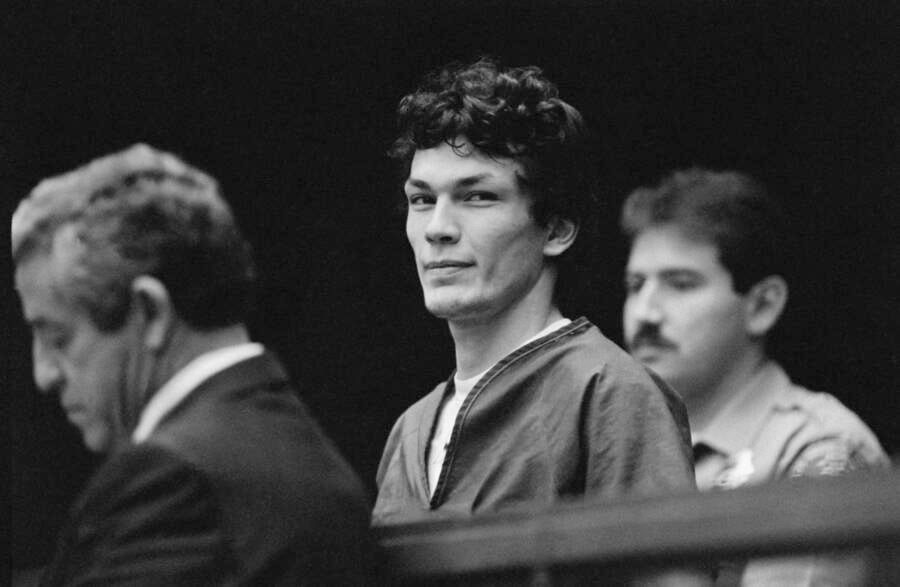
Getty ImagesRichard Ramirez, also known as the “Night Stalker,” terrorized California in 1984 and 1985.
On August 31, 1985, serial killer Richard Ramirez walked into a convenience store in Los Angeles. At first, the man known as the “Night Stalker” acted like any ordinary shopper. But then, he noticed his own face on the cover of a newspaper — and ran for his life.
By that point, Richard Ramirez was already considered the main suspect in the brutal “Night Stalker” murders that had terrorized California for over a year. But authorities had only just released his name and picture to the public.
This gave locals the opportunity to note his appearance — and point him out as he quickly exited the store. Nearly surrounded, Ramirez had very little chance of getting away, but he tried his best to escape.
The ensuing chase involved seven police cars and a helicopter that tracked Ramirez throughout the city. But an angry mob of bystanders caught up to him first. Enraged by his heinous crimes, they began to beat him relentlessly — and at least one man used a metal pipe. By the time the police arrived, Ramirez was practically thanking them for arresting him.
The Night Stalker had begun his brutal killing spree a little over a year before his arrest. In that time, Richard Ramirez murdered at least 13 people — and committed countless other violent acts. But his life of crime started long before that.
- Richard Ramirez’s Traumatic Childhood And Early Crimes
- The Brutal Murders Of The Night Stalker Leave Californians Terrified
- Richard Ramirez’s Victim Count Grows As His Reign Of Terror Continues
- The LAPD Launches A Massive Investigation To Catch The Night Stalker
- The Capture Of The Night Stalker
- The Dramatic Trial And Conviction Of Richard Ramirez
- The Night Stalker’s Final Years In Prison Before His Death in 2013
Richard Ramirez’s Traumatic Childhood And Early Crimes
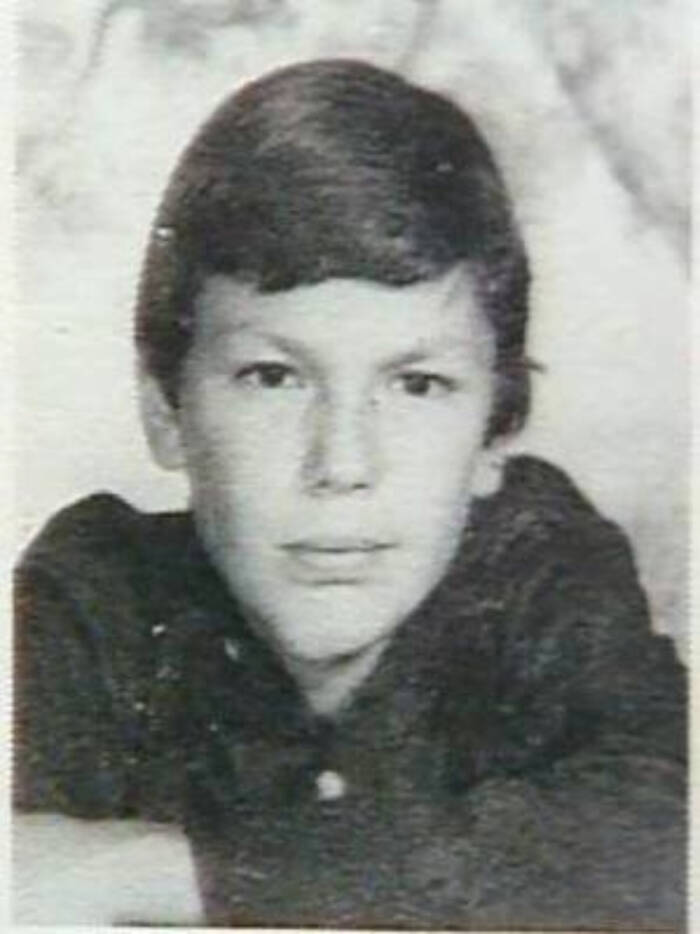
Public DomainRichard Ramirez as a teen. By this point, he had already developed an interest in Satanism, drugs, and violence.
Born on February 29, 1960, Richard Ramirez was raised in El Paso, Texas. Ramirez claimed that his father physically abused him and that he sustained multiple head injuries at an early age. One injury was so severe that it reportedly caused him to have epileptic seizures.
To escape his violent father, Ramirez spent a lot of time with his older cousin, Miguel, who was a Vietnam veteran. Unfortunately, Miguel’s influence wasn’t that much better than his father’s had been.
During his time in Vietnam, Miguel had raped, tortured, and even dismembered several Vietnamese women. And sickeningly, he had the photographic evidence to prove it. He often showed “little Richie” photos of the horrors he inflicted upon the women.
And when Ramirez was just 13 years old, he witnessed his cousin fatally shoot his own wife. Shortly after the shooting, Ramirez began to transform from a scared, abused boy to a hardened, sullen young man.

ARCHIVIO GBB/Alamy Stock PhotoRamirez in a high school photo at age 18.
From developing an interest in Satanism to becoming addicted to drugs, Ramirez’s life took a dark turn. Even worse, he was still under his cousin’s influence — since Miguel had been found not guilty of the murder by reason of insanity. (Miguel ultimately spent just four years in a mental hospital until he was released.)
Before long, Ramirez developed an obsession with the same kinds of sexual and physical violence that Miguel had inflicted on the women in his photos. Ramirez also began to have more run-ins with the law — especially after he moved to the Los Angeles area in California.
Though most of his early crimes in the late 1970s and early 1980s were related to theft and drug possession, it would only be a matter of time before they escalated to unspeakable violence.
The Brutal Murders Of The Night Stalker Leave Californians Terrified
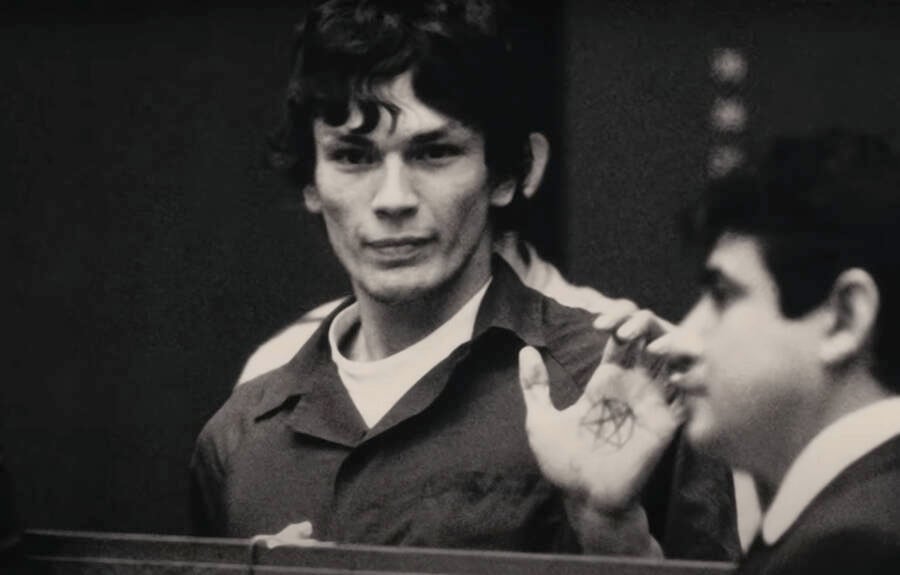
NetflixEven after he was arrested, Richard Ramirez often publicly flaunted his Satanism.
For a long time, Ramirez’s first murder was believed to have taken place on June 28, 1984. It was then that he killed 79-year-old Jennie Vincow. Not only did Ramirez stab and sexually assault his victim, he also slashed her throat so deeply that she was nearly decapitated.
But decades after Ramirez was arrested in 1985, he was also linked by DNA evidence to the murder of a 9-year-old girl, which took place on April 10, 1984 — months before the Vincow murder. So that may well have been his first killing — unless there were even more that happened before that.
After the Vincow murder, it would be several months before Richard Ramirez struck again. But when he did, he pursued his depraved impulses with horrific dedication.
On March 17, 1985, Ramirez’s murder spree began in earnest with an assault on Maria Hernandez in her home. Though Hernandez managed to escape, her roommate Dayle Okazaki was not so lucky. That evening, Okazaki became another one of Ramirez’s murder victims.
But Ramirez still wasn’t done. Later that same night, he shot and killed yet another victim named Tsai-Lian Yu.
A little over a week later, Ramirez murdered 64-year-old Vincent Zazzara and his 44-year-old wife, Maxine. Sickeningly, it was then that Ramirez began to establish his signature style of attack: shoot and kill the husband, then assault and stab the wife. But his murder of Maxine was especially ghastly — as he’d gouged out her eyes.
For months, Ramirez would continue to stalk and murder more victims in California — striking fear in the hearts of people all throughout the state.
Richard Ramirez’s Victim Count Grows As His Reign Of Terror Continues
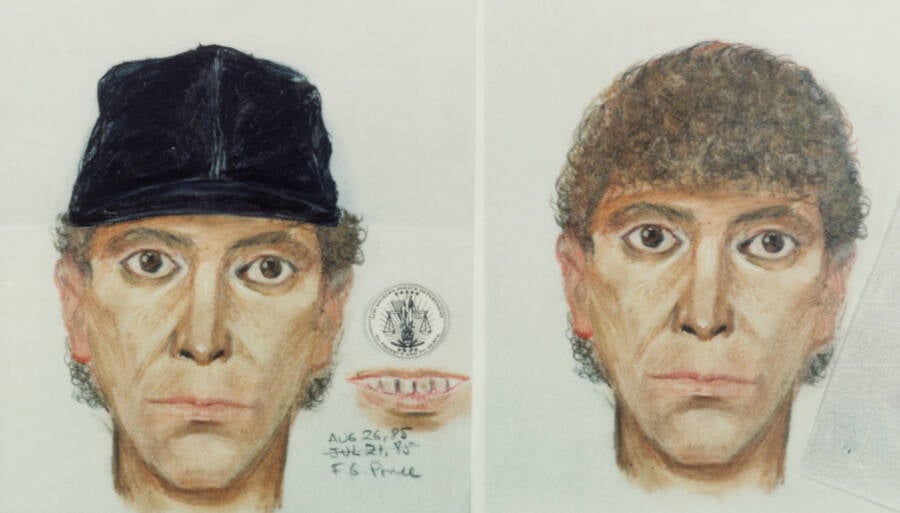
Bettmann/Getty ImagesPolice sketches of the Night Stalker from 1985.
One of the most terrifying things about Ramirez was that he was willing to kill just about anyone who crossed his path. Unlike some other serial killers who have a “type,” Richard Ramirez murdered both men and women and preyed on victims both young and old.
Of the victims investigators are currently aware of, two were under the age of 18 while the rest were between 30 and 83 years old.
At first, it seemed like Ramirez was only attacking people near Los Angeles, but he soon claimed a couple of victims near San Francisco as well. And since the press dubbed him the “Night Stalker,” it was clear that most of his crimes happened at night — adding yet another scary element.
Disturbingly, many of his attacks included a Satanic element as well. In some cases, Ramirez would carve pentagrams into his victims’ bodies. And in other cases, he would force victims to swear their love for Satan.
All over California, people went to bed fearing that the Night Stalker would break into their homes while they slept — and perform an unspeakable ritual of rape, torture, and murder. Since he apparently attacked at random, it truly seemed like no one was safe.
The LAPD increased their presence on the street and even created a special task force just to find him — with the FBI lending a hand. Meanwhile, the public anxiety was so intense around this time that there was a noticeable surge in the sales of guns, lock installations, burglar alarms, and attack dogs.
The LAPD Launches A Massive Investigation To Catch The Night Stalker
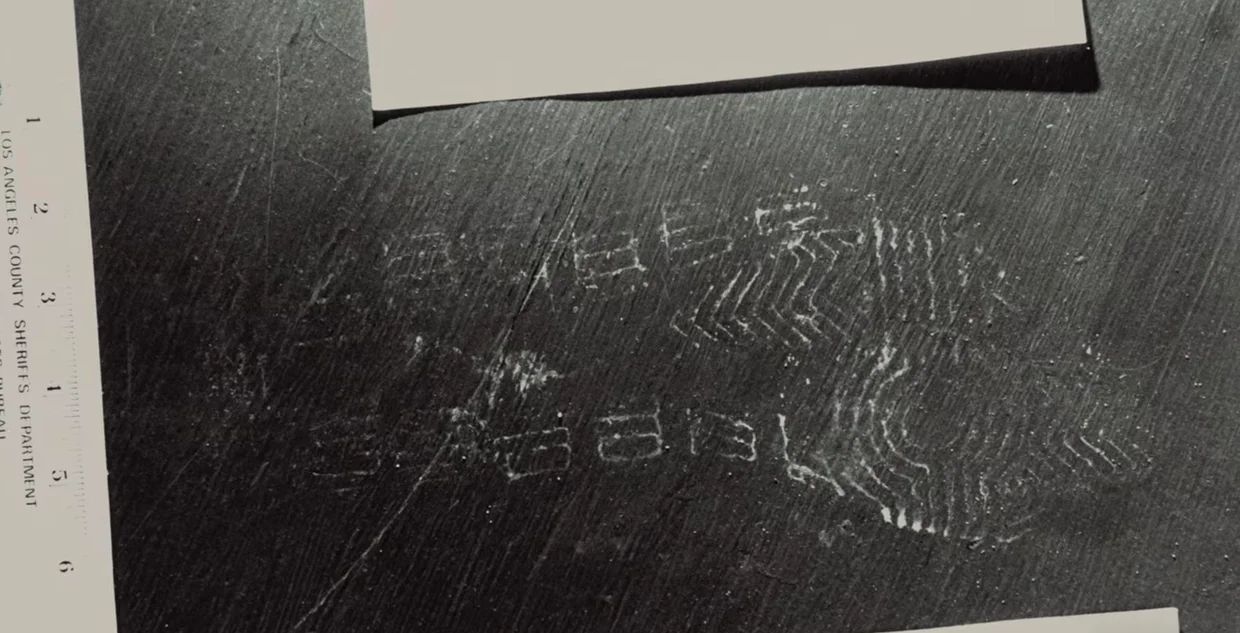
NetflixThe footprint left by Ramirez at one of the crime scenes.
Ultimately, it was Richard Ramirez’s own mistakes that led to his capture. On July 7, Ramirez broke into the home of 60-year-old Joyce Lucille Nelson and left behind his footprint. Unfortunately for Ramirez, the 11-1/2 size Avia sneaker he wore was very unique.
On August 18, after brutally slaying 66-year-old Peter Pan and 63-year-old Barbara Pan, Ramirez once again left a footprint behind, and the authorities were able to match it to the one left at the home of Nelson.
A few days later, Ramirez was spotted outside the home of James Romero Jr. Romero’s 13-year-old son woke the family up after hearing footsteps around the house, and the family was able to catch key details about Ramirez’s car, including a partial license plate number.
When the police tracked down the vehicle, they were able to find just enough of a fingerprint to make a match. Later, the shoe manufacturer informed police that only six of those specific shoes were sold, and only one store in Los Angeles sold them. These pieces of evidence were more than enough to lead to Richard Ramirez, but by that point, they had already received a tip that someone with the last name of Ramirez was involved.
A local woman had called the police after her father told her that he met someone named “Rick” from El Paso, Texas, who bragged about committing the crimes and discussed confidential details. Later, Armando Rodriguez, a friend of Ramirez, also told the police that they were looking for Richard Ramirez.
Sure enough, the LAPD was able to identify Richard Ramirez thanks to their new computer database of fingerprints. And even though the records only included criminals who were born after January 1960, it just so happened that Ramirez was born in February 1960.
Identification was also made possible through the joint effort of both the LAPD and the San Francisco Police Department. Prior to Ramirez, separate law enforcement agencies rarely worked together to solve crimes.
“Back them detectives kept a lot of their information to themselves and a lot of times when that happens, cases don’t get solved,” Scott Carrier, a former Los Angeles Department of Coroner investigator, told the Los Angeles Daily News. “You see a lot more of these task forces-type units today.”
Authorities soon found Ramirez’s mugshots from his prior arrests, and one of his surviving victims, 29-year-old Inez Erickson, came forward with a detailed description that was quite similar to the photos. By the end of August 1985, police decided to release the Night Stalker’s image and name.
Though they initially worried that this would give Ramirez a chance to escape, it turned out that he was blissfully unaware of his newfound publicity — until it was too late.
The Capture Of The Night Stalker
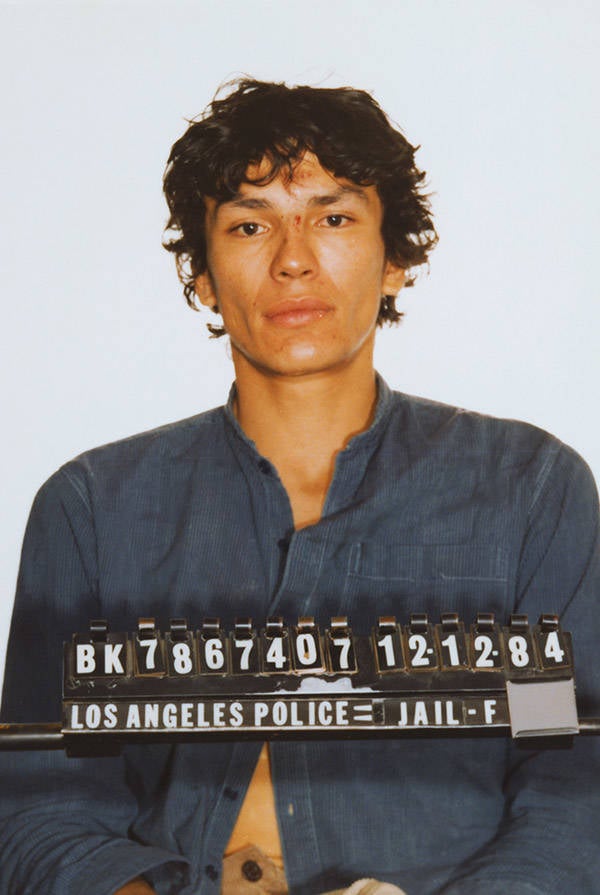
Getty ImagesRichard Ramirez was convicted of 13 murders, five attempted murders, 11 sexual assaults, and 14 burglaries. Decades later, he was linked to another rape and murder — of a nine-year-old girl.
By pure happenstance, Richard Ramirez was traveling back to Los Angeles when his photo was released. So he didn’t realize that he had been tracked down until he was back in the city — and he saw his own face on the newspapers.
On August 31, Ramirez returned to Los Angeles after a short trip to see his brother in Tucson, Arizona. When he arrived at the bus station, he walked past police officers who were tasked specifically with looking for the Night Stalker. Then, he entered a convenience store and browsed the aisles before seeing something that stopped him in his tracks: his face plastered in the newspaper La Opinión with a headline calling him “Invasor Nocturno,” or the “Night Invader.”
A group of elderly women in the store recognized Ramirez and began a commotion, causing Ramirez to flee in a panic. The killer ran across a freeway and attempted to steal a car in a nearby neighborhood. Two residents, Faustino Pinon and Jose Burgoin, ripped Ramirez out of the car and chased after him when he fled.
Then, when Ramirez tried to highjack yet another car, he was hit over the head with a fence post. Soon, a mob of nearly a dozen people who recognized him and his notoriously bad teeth from all of the press coverage, began to violently beat him in the street until the police arrived.
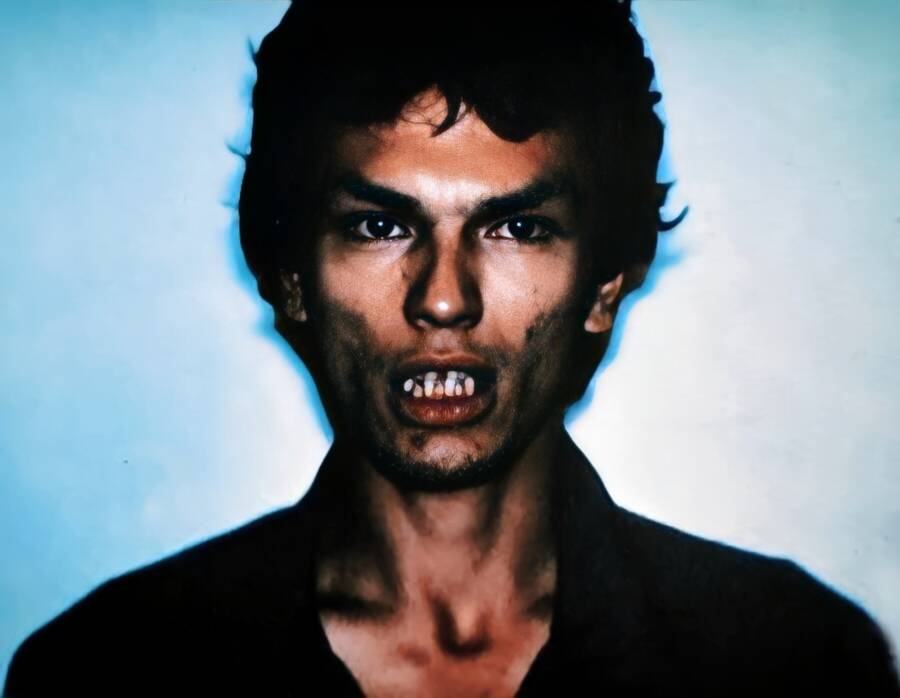
YouTubeBy the time he was arrested, high sugar consumption and cocaine use had rotted Richard Ramirez’s teeth.
One resident, Eloise Cabral, told the Los Angeles Times in 1985 that the neighborhood was just waiting for an opportunity like this.
“We were saying that if he got caught around here in East L.A. he’d probably get his butt beat up because all the guys around here all know about him,” she said. “They would just love to get their hands on him. And now we wake up the next morning and find him across the street.”
The LAPD arrested the badly-beaten Ramirez and charged him with 13 counts of murder. In addition to the murder charges, authorities also charged him with several rapes, assaults, and burglaries.
The Dramatic Trial And Conviction Of Richard Ramirez
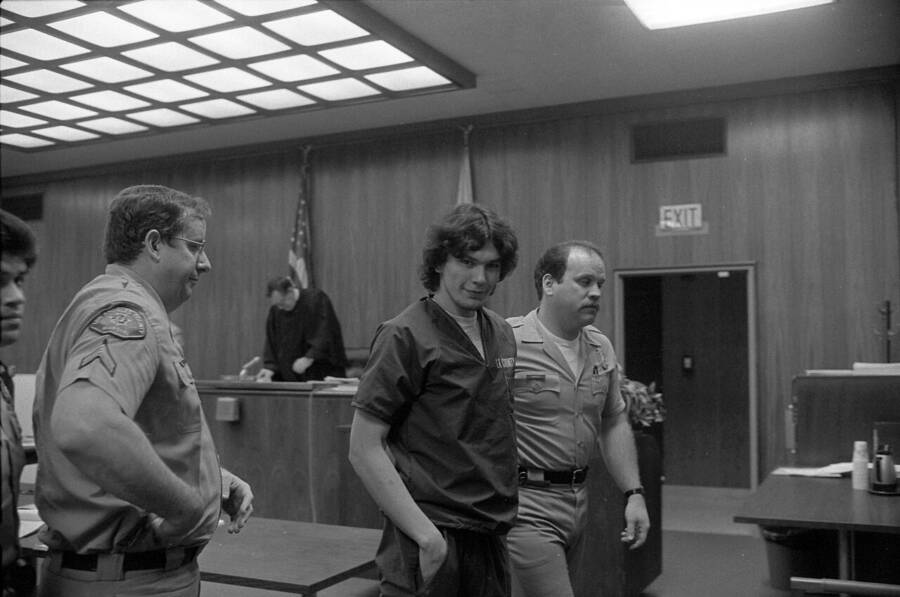
Wikimedia CommonsRamirez being escorted from court by sheriffs.
At first, Richard Ramirez refused to discuss his crimes while in police custody. Angry at being caught and seemingly embarrassed about the way it happened, Ramirez remained withdrawn and silent.
However, when he learned about the attention he was receiving in the media, and the possibility of receiving more, he opened up like a book.
During his trial, which began in July 1988, Ramirez increased the theatrics, drawing pentagrams on his hand and stating “Hail Satan” to the crowded spectator area in court. Because of the high-profile nature of the case, and the fact that it was a capital murder case, it took the court six months to select a jury.
Even the attorneys were not immune to the fanfare. Ramirez’s own lawyers were inexperienced and had never worked a death penalty case before. However, they agreed to represent Ramirez pro bono if they could have the rights to any future movie made about him.
During the trial, there was ample evidence against Ramirez, including dental records, eyewitness accounts, and physical evidence. This, combined with his lackluster legal representation, led to Ramirez being sentenced to death in the gas chamber for his crimes on September 20, 1989 — a sentence that garnered no emotion other than joy from the Night Stalker.
Later, Ramirez explained his joy: “I am beyond good and evil. I will be avenged. Lucifer dwells in us all. That’s it.”
In total, the trial cost the state $1.8 million, the most expensive murder trial in California history until that of O.J Simpson for the murder of Nicole Brown Simpson and Ron Goldman.
The trial also changed the way the California legal system operated. Before Ramirez, judges were expected to hold several hearings a day even when high-profile cases like Ramirez’s were still active.
“Back then they didn’t, so some days (Judge Michael Tynan) had to hold several hearings before he could get back to our trial. It meant even when court would open at 8:30, there were days we didn’t start until 1:30,” Deputy Deputy District Attorney Alan Yochelson, a prosecutor in the case, told the Los Angeles Daily News.
The Night Stalker’s Final Years In Prison Before His Death in 2013
Following his trial, Richard Ramirez was sent to San Quentin State Prison, an infamous spot known for housing California’s most brutal killers.
While he did receive a death sentence, Ramirez was never executed. Due to the complicated nature of his case — which included a 50,000-page trial record — the state’s Supreme Court wasn’t able to hear his appeal until 2006. And even though the court rejected his claims, additional appeals would’ve taken several more years.
During this extended delay, Richard Ramirez met a female admirer named Doreen Lioy who had struck up a correspondence with him. And in 1996, he married her while he was on death row.
“He’s kind, he’s funny, he’s charming,” Lioy said one year later. “I think he’s a really great person. He’s my best friend; he’s my buddy.”
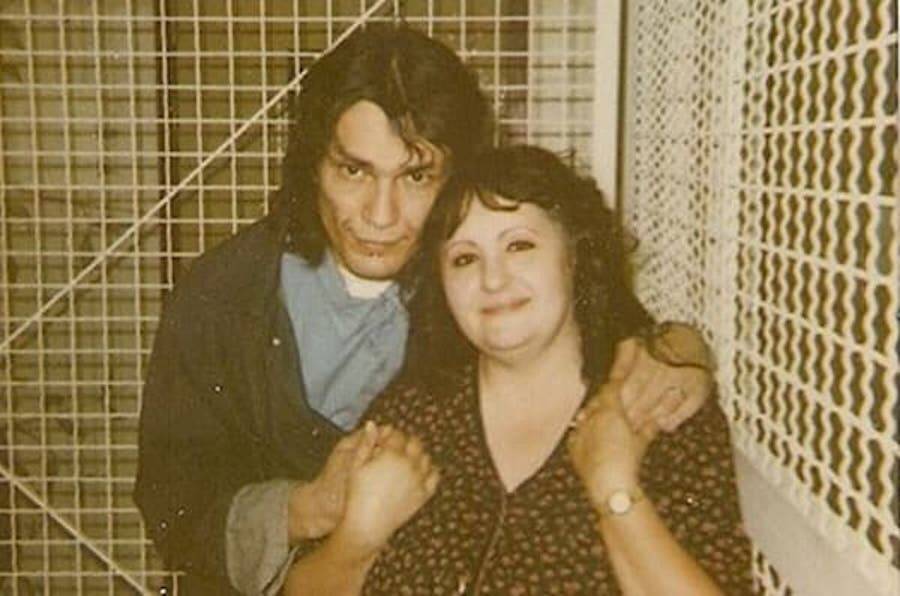
TwitterDoreen Lioy allegedly separated from her infamous husband before he died in 2013.
Obviously, most people did not share her feelings. For the countless Californians who lived in terror during the mid-1980s, Ramirez was little better than the Devil he worshiped.
“It’s just evil. It’s just pure evil,” said Peter Zazzara, the son of victim Vincent Zazzara, in 2006. “I don’t know why somebody would want to do something like that. To take joy in the way it happened.”
Ultimately, Richard Ramirez died of complications from B-cell lymphoma, a cancer of the lymphatic system, in 2013. He was 53 years old.
While he was alive, the Night Stalker never expressed remorse for any of his crimes. In fact, he often appeared to take pleasure in his infamy.
“Hey, big deal,” he said, shortly after getting the death sentence. “Death always comes with the territory. I’ll see you in Disneyland.”
Who was Richard Ramirez?
Known as the Night Stalker, Richard Ramirez was a serial killer who burglarized, raped, and murdered a series of victims in several locations throughout California between April 1984 and August 1985.
Why was Richard Ramirez called the Night Stalker?
The media dubbed Richard Ramirez the Night Stalker due to his modus operandi of breaking into his victims’ homes in the dead of night. He was first given the name by the Los Angeles Herald Examiner, whose editorial staff rejected the name at first and considered other options like the “Walk-in Killer” and the “Screen-Door Intruder” before finally settling on the “Night Stalker.”
Ramirez was known to then use the nickname himself, including during his attack on Inez Erickson in the early morning hours of August 25, 1985. After robbing her, shooting her husband, and raping her, he told Erickson, “Tell them the Night Stalker was here.”
How many people did Richard Ramirez kill?
Richard Ramirez was convicted of 13 murders, five attempted murders, 11 sexual assaults, and 14 burglaries, but, as FBI records show, many believe he may have had more victims.
How did the Night Stalker kill his victims?
Ramirez used various methods, including shooting, stabbing, bludgeoning, and strangulation. He also employed a number of different weapons, ranging from electrical cords to pistols to a hammer. Afterward, he would sometimes mutilate the bodies, including leaving Satanic symbols on the corpses or elsewhere around the crime scenes.
Did any of the Night Stalker’s victims survive?
Several of Richard Ramirez’s victims did survive. He left some of them alive after sexually assaulting them, such as Inez Erickson in August 1985.
Meanwhile, he intended to kill others, though they ended up not dying from their wounds. Among these victims was Maria Hernandez, who Ramirez attacked on March 17, 1985, shooting her in the face — not realizing that the bullet ricocheted off her keys as she lifted her hands to protect herself, allowing her to play dead until he fled the scene.
How was Ramirez eventually caught?
Ramirez was spotted by would-be victim James Romero as he prepared to break into their home on August 24, 1985. Romero was able to give police a description of Ramirez’s stolen car as well as a partial license plate number. Police found the car abandoned in Los Angeles four days later and managed to get one partial fingerprint off the rearview mirror, which conclusively identified the Night Stalker as Richard Ramirez.
After his name and photo were circulated, Ramirez was spotted by several people on the streets of East Los Angeles on August 31. A small mob quickly formed, chasing down Ramirez and beating him into submission before police arrived at the scene and took him away.
What happened to Richard Ramirez after he was imprisoned?
Ramirez was convicted of all charges on September 20, 1989, and sentenced to death six weeks later. However, he sat on death row in San Quentin State Prison for many years, and filed several appeals over the years that never ended in his favor. Finally, he died of complications due to B-cell lymphoma at Marin General Hospital in Greenbrae, California, on June 7, 2013 at age 53.
Did Richard Ramirez have a wife?
Ramirez married Doreen Lioy, a woman who began writing him while he was on death row in 1985. He proposed to her in 1988 and they were married at San Quentin State Prison on October 3, 1996.
Now that you’ve read about serial killer Richard Ramirez, the “Night Stalker,” learn about more of history’s worst serial killers. Then, take a look at these 21 serial killer quotes that will chill you to the bone.





